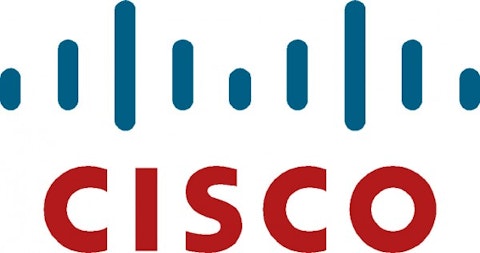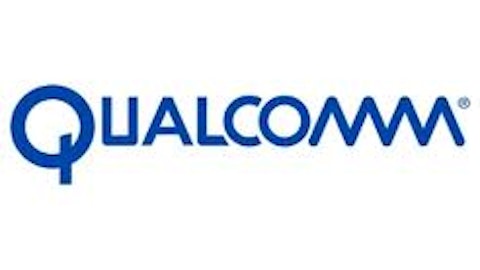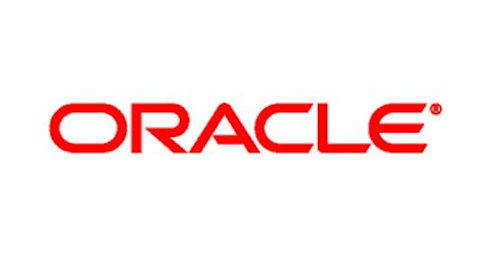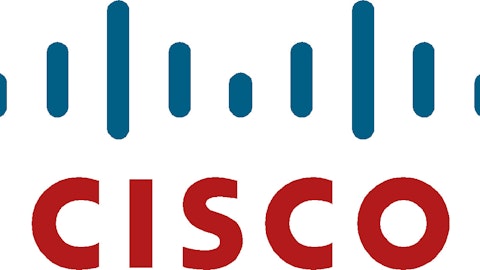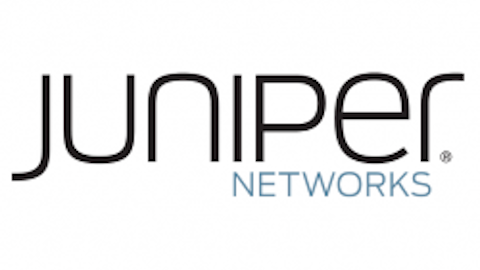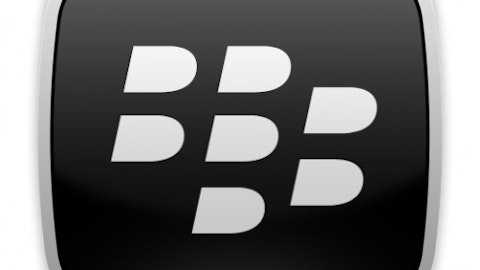Significant scale advantages, meaningful customer switching costs, and a reputation as the go-to provider of enterprise-class networking equipment give Cisco Systems, Inc. (NASDAQ:CSCO) a durable competitive advantage in its core markets of routing and switching.
The firm has emerged from a challenging three-year period as a leaner, more focused competitor. I believe Cisco Systems, Inc. (NASDAQ:CSCO) is well positioned in 2014 to maintain market share and operating margins, and its long-run competitive advantages remain intact.
Cisco Systems, Inc. (NASDAQ:CSCO)’s dominance in data networking is clear. Its Ethernet switches, which move data along local computer networks, are ubiquitous in corporate data centers. Cisco’s share of the switch market has remained above 60% in each of the past five years, while recent efforts from Huawei, Hewlett-Packard Company (NYSE:HPQ), Juniper Networks, Inc. (NYSE:JNPR) and Brocade Communications Systems, Inc. (NASDAQ:BRCD) have yet to make a meaningful dent in Cisco Systems, Inc. (NASDAQ:CSCO)’s share.
Brocade
Brocade Communications Systems, Inc. (NASDAQ:BRCD) is well positioned to remain the market leader in fiber-channel storage switches, its largest and most profitable business. These switches move data among companies’ servers and storage arrays, and continue to be the dominant technology for mission-critical applications. Although Cisco remains a strong competitor, the majority of Brocade’s fiber-channel switch revenue comes from OEM arrangements with large server and storage vendors like Hewlett-Packard Company (NYSE:HPQ), International Business Machines Corp. (NYSE:IBM), and Dell Inc. (NASDAQ:DELL). Cisco Systems, Inc. (NASDAQ:CSCO)’s entrance into the server market has strained its relationships with these large OEMs and strengthened Brocade Communications Systems, Inc. (NASDAQ:BRCD)’s competitive position in the fiber-channel switch industry.
Brocade’s fiber channel business will maintain its market leadership for years to come. However, I think Brocade will struggle to both grow and meaningfully improve profitability in its Ethernet segment, and shareholders would be better off if the firm sold its Ethernet business and returned the bulk of the cash generated from its storage business to shareholders.
Cisco Systems, Inc. (NASDAQ:CSCO)’s routers, used by telecom and cable service providers to move data across long distances, are also the market favorite. Although Chinese competitor Huawei is trying to push into Western markets, we expect Cisco and Juniper Networks, Inc. (NYSE:JNPR) to maintain their virtual duopoly in high-end core routers, with Cisco the clear leader.
Juniper’s down but not out
Juniper reports two product segments: platform systems (primarily routers and switches) and software solutions, which sells appliances that help to secure networks and monitor and shape network traffic. The platform systems division accounts for about 75% of revenue and the software group about 25%.
Juniper Networks, Inc. (NYSE:JNPR) entered the switch market organically in 2008 and increased revenue to more than $550 million in 2012, an impressive feat given Cisco’s CSCO well-established footprint and the maturity of the industry. Juniper’s recently launched QFabric switch platform hasn’t gained strong adoption as a core data center platform, but it has gained adoption for edge server aggregation. Juniper will be viewed as the second-best strategic supplier option, next to Cisco, in data center environments, and I expect Juniper to gain share at the expense of Brocade and other smaller competitors.
Juniper’s software business is primarily composed of network security, and its primary competitors in network security include established vendors such as Cisco and Check Point Software Technologies Ltd. (NASDAQ:CHKP), along with a rash of newer entrants including Fortinet Inc (NASDAQ:FTNT), Palo Alto Networks Inc (NYSE:PANW), and F5 Networks, Inc. (NASDAQ:FFIV).
Cisco’s lead is intact
I expect Cisco to successfully defend its lead in core routers for many years. Its competitive position in edge routers is not as pronounced, but recent improvements to its product portfolio should ensure Cisco remains a leading player in this oligopoly. Switches and routers account for nearly two thirds of Cisco’s product revenue. The remaining portion comes from a collection of smaller businesses, most of which are adjacent and high quality, like data center, enterprise wireless, and security.
Given Cisco’s extensive product portfolio and broad reach into enterprises’ and service providers’ IT environments, I like management’s strategy of increasing its service capabilities, product integration, and software revenue. Services has been an area of strength for the company over the past five years, with double-digit annual service revenue growth in 22 of the past 27 quarters and no year-over-year declines over the same period. Also, service gross margins have recently pushed into the mid- to upper 60s, above the corporate average. Current go-to-market vehicles such as CloudVerse and Vblock demonstrate Cisco’s ongoing efforts to deliver integrated products and services.
Positive Points
- The long-term demand outlook for carrier routers remains solid as voice, video, and data networks converge toward IP. As Internet traffic grows (by 50% or more per year, according to most estimates), demand for Cisco’s networking gear will grow.
- Cisco’s share of the Ethernet switch market has held relatively steady in recent years despite increasing competition from Hewlett-Packard Company (NYSE:HPQ), Brocade, and Juniper. The status quo is still the first option for mission-critical switch installations.
- With almost $6 per share in net cash, $1.80 per share in normalized free cash flow, and a 3% dividend yield, downside risk is limited at current levels.
- Management has committed to return 50% of free cash flow to shareholders annually. The annual dividend of $0.68 per share could easily grow 10% per year over the next five years without limiting Cisco’s financial flexibility.
Conclusion
Cisco announced its intent to acquire privately held data integration and data analytics firm Composite Software for $180 million in cash and incentives. This acquisition is too small to move the needle, though Cisco continues to acquire smaller firms at a rapid pace in order to push further into software. Composite will be Cisco’s sixth acquisition of 2013 and 13th acquisition over the past 12 months. While Cisco has a solid long-term record of effectively integrating smaller acquisitions, we cannot ignore the fact that integration risk rises as the pace of M&A increases.
Ahsan Aslam Khan has no position in any stocks mentioned. The Motley Fool recommends Cisco Systems. Ahsan is a member of The Motley Fool Blog Network — entries represent the personal opinion of the blogger and are not formally edited.
The article Cisco’s Clear Dominance in Data Networking originally appeared on Fool.com is written by Ahsan Aslam.
Copyright © 1995 – 2013 The Motley Fool, LLC. All rights reserved. The Motley Fool has a disclosure policy.
